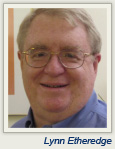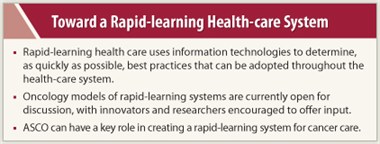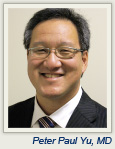If we are able to harness the full potential of digital technologies, computerized registries, databases, and the Web, could we solve many of the current woes of our sluggish and costly health-care system? Yes, according to Lynn Etheredge, a consultant with the Rapid Learning Project at the George Washington University in Washington, DC, who presented a session titled, “A Rapid-Learning Healthcare System” at the recent ASCO Health IT/EHR [Health Information Technology/Electronic Health Records] Symposium in Atlanta.
What Is a Rapid-learning Health-care System?
 According to Mr. Etheredge, we have the technologies at hand to build a rapid-learning health-care system that would accelerate our clinical research and trial system. “The objective of a rapid-learning health-care system is simply to learn as fast as possible about what is the best treatment for each patient—and deliver it,” Mr. Etheredge commented.
According to Mr. Etheredge, we have the technologies at hand to build a rapid-learning health-care system that would accelerate our clinical research and trial system. “The objective of a rapid-learning health-care system is simply to learn as fast as possible about what is the best treatment for each patient—and deliver it,” Mr. Etheredge commented.
Conceptually, a rapid-learning system speaks to some of the major problems in our current system: clinical practice variations, poor quality, lack of comparative effectiveness research, rising costs, ineffective markets, and an inefficient regulatory body. “In short, a fully implemented rapid-learning system addresses the issue of delivering personalized therapy by advancing translational science and evidence-based medicine,” Mr. Etheredge said.
A key concept in this initiative is “in silico” research—using massive computerized databases and research networks for cutting-edge science that compliments in vivo and in vitro methods. “In silico research gives us the potential to learn much faster. Using this approach, we’ll be able to study many more patients than allowed by our current clinical trial system,” Mr. Etheredge explained.
Incomplete Equation
 Having access to large databases with richer and longitudinal data creates an atmosphere in which many more researchers can conduct different and faster studies. “Today, researchers who want to test an idea must apply for a grant and do preliminary data collection. It is a multiyear process. However, many researchers, such as astronomers, log onto their computer in the morning and access evidence-based data that has already been predigested by high-speed computer programs,” Mr. Etheredge said.
Having access to large databases with richer and longitudinal data creates an atmosphere in which many more researchers can conduct different and faster studies. “Today, researchers who want to test an idea must apply for a grant and do preliminary data collection. It is a multiyear process. However, many researchers, such as astronomers, log onto their computer in the morning and access evidence-based data that has already been predigested by high-speed computer programs,” Mr. Etheredge said.
The end result: Linking high-speed computer systems to robust databases would allow researchers to test multiple hypotheses—in what now takes years to get results—in a matter of a few days.
Mr. Etheredge uses a fairly straightforward model to capture the essence of a rapid-learning health-care system: RL = R + C + D + Apps. “R is for great researchers and C is for very fast computers. We have both of those. D is for databases. We don’t have a national system of high-quality clinical research registries and databases that are predesigned, prebuilt, and prepopulated for answering the questions we’re likely to ask in a rapid learning system,” Mr. Etheredge noted.
Mr. Etheredge continued, “Most rapid-learning questions are applied research—in other words, treatment A vs treatment B for subpopulation C. We need specific data that will answer the questions and electronic health records to enable the researcher to access the new, data-rich environment in a computable world of clinical evidence.”
“Finally,” Mr. Etheredge concluded, “I’ve come to realize that we need a whole new world of apps: user-friendly software to acquire, share, analyze, and use computable data in a quick and efficient manner, to develop the necessary clinical tools such as predictive modeling. That is the broad concept of a rapid-learning health-care system in a nutshell.”
Oncology Rapid-learning System
The session’s second presenter, Peter Paul Yu, MD, of Palo Alto Medical Foundation, distilled the rapid-learning health-care system concept into two oncology models. “The principles of a rapid-learning health-care system are learning from every patient experience, identifying the useful data within the tsunami of data out there, then using the “extract, transform, and load” process to mine and aggregate the data for knowledge creation that ultimately is applied at the point of oncology care. From there, we iterate and innovate,” Dr. Yu commented.
Model A: Clinical Practice Quality and Guidelines
 “Our guidelines condense knowledge into clinical recommendations. In an ideal world, the guidelines would be linked to outcomes measures to determine not only how one should proceed in a certain situation, but to establish whether following this recommendation would achieve an outcome that will improve clinical results,” Dr. Yu said, explaining that a computerized clinical decision support instrument is necessary to get full value from the guidelines.
“Our guidelines condense knowledge into clinical recommendations. In an ideal world, the guidelines would be linked to outcomes measures to determine not only how one should proceed in a certain situation, but to establish whether following this recommendation would achieve an outcome that will improve clinical results,” Dr. Yu said, explaining that a computerized clinical decision support instrument is necessary to get full value from the guidelines.
“We should not expect a busy clinician to go to the ASCO site and open a 100-page guideline document, breeze through it and return to the patient with a treatment decision. It needs to be a seamless computerized process, in which the EHR has the software to instantly mine the data and guidelines and make the recommendation,” Dr. Yu said.
The outcomes from that individual patient would then be uploaded into a knowledge-based registry such as the Quality Oncology Practice Initiative (QOPI®), where we can perform analytics that in turn would feed the digested data back into the guidelines, creating an organic system of continual updates. “We’re a long way off from a seamless guidelines-to-patient process,” he conceded.
Dr. Yu reviewed challenges to the existing ASCO Guidelines process, many of which relate to the time and resources required to conduct a systematic review of the literature. He cited the need for future efforts to integrate outcomes measurement and identify and fill knowledge gaps, along with a development process that ensures that recommendations are integrated into EHRs to most successfully inform daily cancer care. Moreover, he pointed out that the QOPI quality assessment process is constrained by a number of factors, such as being chart abstraction–based and retrospective, rather than real-time.
“To rework cancer care delivery into a rapid-learning system will take sociotechnologic change, with an emphasis on the societal arm. We need greater precision, and that means developing computer-based clinical decision support tools that can help us analyze, measure, and deliver much better health and economic outcomes,” Dr. Yu stressed.
Model B: Clinical Trials and Personalized Medicine
“The core principle of model B is that we learn from every patient on trial. However, clinical trials are not patient-centric, they are not rapid, and nonresponders and rare responders are ignored. In short, trials are more about the drugs than the patients,” Dr. Yu commented.
To move toward a personalized health model, Dr. Yu said it is incumbent to learn from complex molecular data, and we need to make randomized clinical trials rapid-learning. “EHRs that can access molecular data and are certified for clinical research are an essential component in reshaping our clinical trial system. We also need more pragmatic trial design and health information exchanges,” Dr. Yu said.
Dr. Yu emphasized that to develop a rapid-learning health-care system, we need to follow and learn from individual patients; those experiences generate population data that inform health and economic outcomes. “Simply put, rapid-learning conflates high-grade research and routine health-care delivery,” Dr. Yu concluded. ■
Disclosure: Dr. Yu and Mr. Etheredge reported no potential conflicts of interest.

